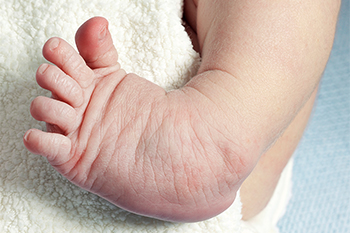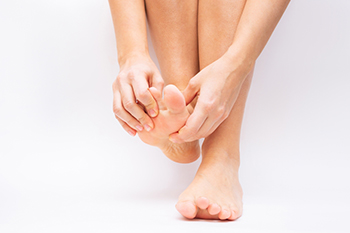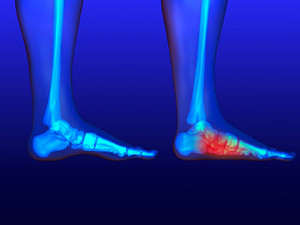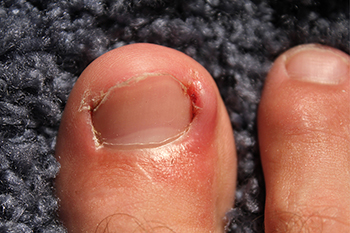Connect With Us
Blog
Items filtered by date: June 2023
Dealing With Clubfoot in Babies

Clubfoot is a congenital foot defect that can be detected before birth, but usually is diagnosed after the baby is born. Soon thereafter, treatment can begin. A clubfoot, also called talipes, is characterized by the foot pointing down and inward with the sole facing backward. It can affect one or both feet, but is not painful for babies. A treatment called the Ponseti method is frequently the first step in correcting clubfoot. During this process, the baby’s foot is manipulated into the correct position and placed in a cast. The process is repeated frequently as the baby grows. After the cast is permanently removed, minor surgery may be required to loosen the Achilles tendon. After that, the baby will wear special boots to prevent the clubfoot from returning. These boots will be worn daily for three months, and then as the baby ages, the boots are worn at night until they are about five years old. Most babies respond well to this treatment, and begin to walk normally. For further information about clubfoot, it is suggested that you consult a podiatrist.
Congenital foot problems require immediate attention to avoid future complications. If you have any concerns, contact one of our podiatrists of Sutera and Jones Surgical Podiatry. Our doctors can provide the care you need to keep you pain-free and on your feet.
Congenital foot problems are deformities affecting the feet, toes, and/or ankles that children are born with. Some of these conditions have a genetic cause while others just happen. Some specific foot ailments that children may be born with include clubfeet, polydactyly/macrodactyly, and cleft foot. There are several other foot anomalies that can occur congenitally. What all of these conditions have in common is that a child may experience difficulty walking or performing everyday activities, as well as trouble finding footwear that fits their foot deformity. Some of these conditions are more serious than others. Consulting with a podiatrist as early as possible will help in properly diagnosing a child’s foot condition while getting the necessary treatment underway.
What are Causes of Congenital Foot Problem?
A congenital foot problem is one that happens to a child at birth. These conditions can be caused by a genetic predisposition, developmental or positional abnormalities during gestation, or with no known cause.
What are Symptoms of Congenital Foot Problems?
Symptoms vary by the congenital condition. Symptoms may consist of the following:
- Clubfoot, where tendons are shortened, bones are shaped differently, and the Achilles tendon is tight, causing the foot to point in and down. It is also possible for the soles of the feet to face each other.
- Polydactyly, which usually consists of a nubbin or small lump of tissue without a bone, a toe that is partially formed but has no joints, or an extra toe.
- Vertical talus, where the talus bone forms in the wrong position causing other bones in the foot to line up improperly, the front of the foot to point up, and the bottom of the foot to stiffen, with no arch, and to curve out.
- Tarsal coalition, when there is an abnormal connection of two or more bones in the foot leading to severe, rigid flatfoot.
- Cleft foot, where there are missing toes, a V-shaped cleft, and other anatomical differences.
- Macrodactyly, when the toes are abnormally large due to overgrowth of the underlying bone or soft tissue.
Treatment and Prevention
While there is nothing one can do to prevent congenital foot problems, raising awareness and receiving neonatal screenings are important. Early detection by taking your child to a podiatrist leads to the best outcome possible.
If you have any questions please feel free to contact one of our offices located in Media, Glen Mills, Riddle Memorial Hospital, and Concordville, PA . We offer the newest diagnostic tools and technology to treat your foot and ankle needs.
Why Does My Big Toe Hurt?

There are various reasons why pain in the big toe can happen. The foot condition that is known as gout causes sharp pain in the joints of the big toe. Many people notice the pain can begin at night, and happens as a result of excess uric acid that collects in the toe joints. Having an ingrown toenail can cause intense toe pain. This condition occurs when the nail grows into the skin of the side of the toe instead of over it, and can be accompanied by swelling, redness, and tenderness. The ligaments in the toe are affected when turf toe happens, and can be a common injury among athletes. A bony lump that forms on the side of the big toe may indicate a bunion has developed. The gradual movement of this toe may cause the other toes to shift toward each other, and larger shoes may need to be purchased. If you have toe pain, it is suggested that you confer with a podiatrist who can determine the cause and offer effective treatment solutions.
Toe pain can disrupt your daily activities. If you have any concerns, contact one of our podiatrists of Sutera and Jones Surgical Podiatry. Our doctors can provide the care you need to keep you pain-free and on your feet.
What Causes Toe Pain?
Most severe toe pain is caused due to a sports injury, trauma from dropping something heavy on the toe, or bumping into something rigid. Other problems can develop over time for various reasons.
Toe pain can be caused by one or more ailments. The most common include:
- Trauma
- Sports injury
- Wearing shoes that are too tight
- Arthritis
- Gout
- Corns and calluses
- Hammertoe
- Bunions
- Blisters
- Ingrown toenails
- Sprains
- Fractures (broken bones)
- Dislocations
When to See a Podiatrist
- Severe pain
- Persistent pain that lasts more than a week
- Signs of infection
- Continued swelling
- Pain that prevents walking
Diagnosis
In many cases the cause of toe pain is obvious, but in others, a podiatrist may want to use more advanced methods to determine the problem. These can range from simple visual inspections and sensation tests to X-rays and MRI scans. Prior medical history, family medical history, and any recent physical traumatic events will all be taken into consideration for a proper diagnosis.
Treatment
Treatments for toe pain and injuries vary and may include shoe inserts, padding, taping, medicines, injections, and in some cases, surgery. If you believe that you have broken a toe, please see a podiatrist as soon as possible.
If you have any questions please feel free to contact one of our offices located in Media, Glen Mills, Riddle Memorial Hospital, and Concordville, PA . We offer the newest diagnostic tools and technology to treat your foot and ankle needs.
Conditions That May Cause Flat Feet in Adults

The absence of an arch in the feet is known as having flat feet. It may also be referred to as fallen arches, and adults may retain this condition from infancy. The majority of babies are born with flat feet, and the arch will fully develop during the teenage years. Having an abnormal foot structure may cause the arch to not develop, and may be a painful condition in adults. There may be existing medical conditions in adults that can cause flat feet. These can include weakened tendons, ligament injuries, or rheumatoid arthritis. Flat feet may cause patients to have pain, or a general achiness. Performing specific stretches for flat feet may help to reduce existing discomfort. Additionally, some patients may find relief when custom made orthotics are worn, or may opt for surgery if the pain compromises daily activity. If you have flat feet, it is strongly suggested that you are under the care of a podiatrist who can offer you treatment and relief methods that are correct for you.
Flatfoot is a condition many people suffer from. If you have flat feet, contact one of our podiatrists from Sutera and Jones Surgical Podiatry. Our doctors will treat your foot and ankle needs.
What Are Flat Feet?
Flatfoot is a condition in which the arch of the foot is depressed and the sole of the foot is almost completely in contact with the ground. About 20-30% of the population generally has flat feet because their arches never formed during growth.
Conditions & Problems:
Having flat feet makes it difficult to run or walk because of the stress placed on the ankles.
Alignment – The general alignment of your legs can be disrupted, because the ankles move inward which can cause major discomfort.
Knees – If you have complications with your knees, flat feet can be a contributor to arthritis in that area.
Symptoms
- Pain around the heel or arch area
- Trouble standing on the tip toe
- Swelling around the inside of the ankle
- Flat look to one or both feet
- Having your shoes feel uneven when worn
Treatment
If you are experiencing pain and stress on the foot you may weaken the posterior tibial tendon, which runs around the inside of the ankle.
If you have any questions please feel free to contact one of our offices located in Media, Glen Mills, Riddle Memorial Hospital, and Concordville, PA . We offer the newest diagnostic and treatment technologies for all your foot and ankle needs.
Why Live with Pain and Numbness in Your Feet?
Foot Wounds From Ingrown Toenails

It is important to take care of wounds on the feet immediately. These can come from a variety of sources, including ingrown toenails. This is a condition that develops when the toenail grows into the skin surrounding it instead of over it. The big toe is most likely to be impacted by this ailment. Everyone is at risk of developing ingrown toenails, particularly teens who often have sweaty feet from sports participation. It may also affect elderly people whose nails thicken as time passes. Ingrown toenails can occur from cutting toenails improperly, or if they have an irregular shape or are curved. Additionally, wearing shoes or socks that compress the toes can lead to getting an ingrown toenail. This problem can cause pain and swelling. Complications, namely infections from ingrown toenails, are most apt to happen to those with diabetes or conditions involving poor circulation. An infection from an ingrown toenail might present as red, bleeding, oozing pus, and an overgrowth of skin around the toe. Left untreated, this type of infection can impact the bone in the toe and lead to foot ulcers or open sores. If you have an ingrown toenail that is becoming worse or possibly infected, it is suggested that you see a podiatrist as soon as possible who can provide a proper diagnosis and treatment.
Wound care is an important part in dealing with diabetes. If you have diabetes and a foot wound or would like more information about wound care for diabetics, consult with one of our podiatrists from Sutera and Jones Surgical Podiatry. Our doctors will assess your condition and provide you with quality foot and ankle treatment.
What Is Wound Care?
Wound care is the practice of taking proper care of a wound. This can range from the smallest to the largest of wounds. While everyone can benefit from proper wound care, it is much more important for diabetics. Diabetics often suffer from poor blood circulation which causes wounds to heal much slower than they would in a non-diabetic.
What Is the Importance of Wound Care?
While it may not seem apparent with small ulcers on the foot, for diabetics, any size ulcer can become infected. Diabetics often also suffer from neuropathy, or nerve loss. This means they might not even feel when they have an ulcer on their foot. If the wound becomes severely infected, amputation may be necessary. Therefore, it is of the upmost importance to properly care for any and all foot wounds.
How to Care for Wounds
The best way to care for foot wounds is to prevent them. For diabetics, this means daily inspections of the feet for any signs of abnormalities or ulcers. It is also recommended to see a podiatrist several times a year for a foot inspection. If you do have an ulcer, run the wound under water to clear dirt from the wound; then apply antibiotic ointment to the wound and cover with a bandage. Bandages should be changed daily and keeping pressure off the wound is smart. It is advised to see a podiatrist, who can keep an eye on it.
If you have any questions, please feel free to contact one of our offices located in Media, Glen Mills, Riddle Memorial Hospital, and Concordville, PA . We offer the newest diagnostic and treatment technologies for all your foot care needs.
Blog Archives
- March 2025
- February 2025
- January 2025
- December 2024
- November 2024
- October 2024
- September 2024
- August 2024
- July 2024
- June 2024
- May 2024
- April 2024
- March 2024
- February 2024
- January 2024
- December 2023
- November 2023
- October 2023
- September 2023
- August 2023
- July 2023
- June 2023
- May 2023
- April 2023
- March 2023
- February 2023
- January 2023
- December 2022
- November 2022
- October 2022
- September 2022
- August 2022
- July 2022
- June 2022
- May 2022
- April 2022
- March 2022
- February 2022
- January 2022
- December 2021
- November 2021
- October 2021
- September 2021
- August 2021
- July 2021
- June 2021
- May 2021
- April 2021
- March 2021
- February 2021
- January 2021
- December 2020
- November 2020
- October 2020
- September 2020
- August 2020
- July 2020
- June 2020
- May 2020
- April 2020
- March 2020
- February 2020
- January 2020
- December 2019
- November 2019
- October 2019
- September 2019
- August 2019
- July 2019
- June 2019
- May 2019
- April 2019
- March 2019
- February 2019
- January 2019
- December 2018
- November 2018
- October 2018
- September 2018
- August 2018
- July 2018
- June 2018
- May 2018
- April 2018
- March 2018
- February 2018
- January 2018
- December 2017
- November 2017
- October 2017
- September 2017
- August 2017
- July 2017
- June 2017
- May 2017
- April 2017
- March 2017
- February 2017
- January 2017
- December 2016
- November 2016
- October 2016
- September 2016
- August 2016
- July 2016
- June 2016
- May 2016
- April 2016
- March 2016
- February 2016
- January 2016
- December 2015
- November 2015
- October 2015
- September 2015
- August 2015
- July 2015
- June 2015
- May 2015
- April 2015
- March 2015
- February 2015
- January 2015
- December 2014
- November 2014
- October 2014
- September 2014

